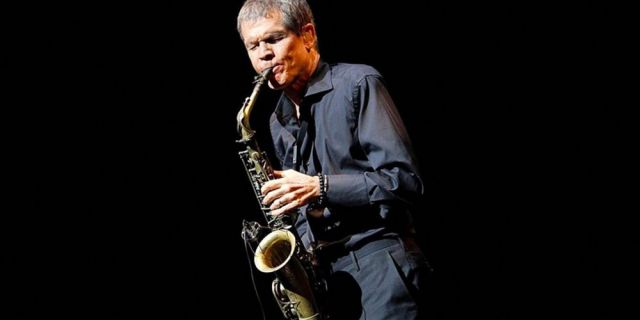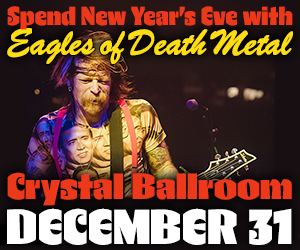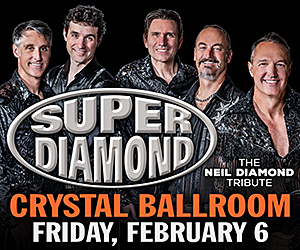Home > Jazz / Blues
02/29/2020
David Sanborn Alto Sax Icons Pt. 1: 2020 Portland biamp Jazz Festival / Review
By MICHAEL "SHOEHORN" CONLEY // David Sanborn kicks off a series of stories on alto players appearing at the 2020 Portland Jazz Festival.
In preparing for the 2020 biamp PDX Jazz Festival, I looked at the schedule and decided I'd like to do a survey of some of the fine alto saxophone players listed on the roster. Between my own performance schedule and other responsibilities, I knew I would be unable to attend every concert featuring alto sax. A while back OMN published my piece on festival artist Donald Harrison, whom I hold in very high esteem.
I have also reviewed Paquito d’Rivera, another favorite of mine going back decades, and Rudresh Mahanthappa, so we can say this is part of an ongoing series with an alto saxophone player reviewing other alto players! Does this raise an issue of journalistic ethics? I am very opinionated and also not nearly as well-known as the players I'm covering! But each of these musicians has their own voice and their own approach to the music, and this creates an opportunity for me to reflect on my own playing, and the analysis involved gives me ideas for things to practice!
David Sanborn will be covered in the first installment of the current series.
Part 1: David Sanborn Jazz Quartet, February 25th, 2020 PDX biamp Jazz Festival at Revolution Hall.
It would be hard to overstate the influence of David Sanborn on alto saxophone players in the modern era. His soulful, amplified sound graced and spiced hits by a panoply of pop artists such as James Taylor, David Bowie, Paul Simon, and Carly Simon, among many other big names, starting in the 1960s with the Paul Butterfield Blues Band. Many critics and sax players alike have tried to put a finger on his signature sound.
I find it difficult to pin down as a saxophone player myself. Commonly described as “bright and edgy”, I find that an inadequate, overly simplistic descriptor. Yes, it is bright, even dry, yet there is vibrato. It’s “hot” but not “warm”, “cool” yet not “dark”, it's attenuated, yet pungent! He's smooth, but with plenty of grit. He definitely emphasizes certain parts of the sound a saxophone makes, and this seems designed to cut through modern instrumentation, by which I mean the sound of electronically reinforced instruments.
This sax tone definitely cuts through the mix of electric guitars, electric basses, and mic'd-up drum sets that defines much of popular music since the 1950s. But it also seems to dramatically limit the tonal spectrum of the saxophone. I would relish an opportunity to hear him play without the mic clipped to the bell of the horn and the requisite EQ.
That said, I will always love him for the 8-note pickup he plays on “Love & Happiness”, one of his biggest hits of the 1980s. That, and his fantastic TV show “Night Music” which he hosted from 1988-90. A gifted broadcast host, he had very creative programming, including an unforgettable pairing of Sonny Rollins with Leonard Cohen. ( He also booked my buddy Artis the Spoonman on one show! )
This concert was billed as the David Sanborn Jazz Quartet. I was curious if this meant he would address standard songbook repertoire, swing rhythms, bebop vocabulary, and perhaps with a more rounded sound from his horn. What he presented was not too far removed from his previous output, drawing on songs by Michael Brecker, Marcus Miller, and other fusion jazz masters.
We did not hear bebop runs replete with hip harmonic substitutions and reverence for a bygone era. What we did get was a fine quartet of great players playing mostly fusion material, but without the adventurous meter shifts and key changes that sometimes characterize the genre. Sanborn excels at playing licks that seem to burst from his horn, with a lot of creative ways of attacking the notes, following these attacks with brief flurries of cool and compelling patterns.
His band featured Geoffrey Keezer on keyboard and piano, Billy Kilson on drums and Bill DaBoo on upright bass. Keezer is a monster player, and having seen him on a previous occasion I had remarked that he made the piano sound much bigger than it actually is, by means of his exuberance, and his formidable chops and conception. His solos during this concert took the source material to new places and brought them back home like miniature concerti. He had a pair of Yamaha Motif keyboards that he played for some of the songs.
Kilson the drummer displayed all the chops expected of a contemporary jazz drummer, with impressive technique filling in the funky beats with cascades around the toms and cymbals. It was interesting to see him dial it back at times during softer moments and play quietly, yet still quite busy.
The first song, the Michael Brecker composition “Tumbleweeds” elicited a bit of the Coltrane quartet sound, mainly due to Keezer's updated Tyner-esque piano chording, but with Kilson playing something quite different than his counterpart in that iconic band, the late Elvin Jones. The second tune, also by Brecker, saw Sanborn adjust the EQ on his horn via an on-stage mixing console set up next to him, rendering the sound slightly wetter but still fairly acerbic.
This tune was more lyrical and less busy, but definitely was rooted in the fusion era in terms of the harmonic content and rhythmic dynamics. Especially interesting was the interplay between piano and drums during the piano solo, with Kilson occasionally playing eighth notes in rhythmic unison with the pianist. Sanborn took it home with hip funk lines over the vamp, ending with softly-voiced, yet well-amplified notes, revealing a certain vulnerability in the lower reaches of the alto.
Next up was Marcus Miller's tune “Maputo” featuring a West African sound with the electric keys setting things up with a balafon patch. This tune featured a smooth waltz feel in the bridge which was in pleasant contrast to the rootsier groove on the A section. Here the band was fairly subdued but Sanborn cut through loud and clear with his reverb and EQ, playing intense runs with relaxed grace, even quoting the old Irving Berlin song “Fascinating Rhythm”. Keezer was pitch-bending on his Yamaha with his right hand, his left hand on the grand piano, answering the electric keyboard phrases, then launched a stunningly fleet passage where he he played the same part in unison on the two instruments, ending his solo by steering the tune into a funk groove before returning to the balafon patch.
Sanborn was definitely an affable presence on stage in his introductions and announcements, which got a little bizarre when he introduced the song “All In the Game” by Charles Dawes, who according to Sanborn had been US president Calvin Coolidge's vice president! Sanborn reminisced about his high school years, when, stereotypically terrified of asking girls to dance, this song was a safe haven in a rendition by Tommy Edwards that had been a hit at the time.
A recent addition to his playbook, this number got a vocalesque reading of the melody, where one could imagine the lyrics falling in place with his horn phrasing. Played in duet with Keezer, the sax man’s confidence came through strongly on this piece, and it was a chance for him to present some of the signature licks and runs I have heard him do on recordings. The song also gave rise to a transformative piano solo invention by Keezer. This was as close as Sanborn got to mainstream jazz repertoire, specifically the saxist’s quoting the song “People” by Jule Styne, closing with a phrase from “When You Wish Upon a Star”.
The show continued with a dedication to the late Roy Hargrove, with the Hargrove/ D’Angelo number titled “Spanish Joint”. For this listener, this song conjured up the memory of Grover Washington,Jr., who would have felt at home in this song. DaBoo the bass player had a nice solo here, quoting Ornette Coleman’s “Lonely Woman”, and Keezer displayed considerable Latin flare without playing any overt Montunos, yet still suggesting the Latin piano sound. His bubbling 16th-note patterns under his solo might have seemed gratuitous if they weren't so gracefully integrated with his right hand ideas.
A tune penned by Sanborn's wife Sofia was played with hints of Freddie Hubbard’s “Little Sunflower”. Here's where Kilson’s drums simmered softly in some of the most sensitive ensemble playing of the whole set.
Next we had “On the Spot” a drum feature which was pretty cool, unleashing Kilson to crowd-pleasing effect, with Keezer profferring upwardly percolating runs, all the while effortlessly absorbing the funk into his virtuoso extemporization. The drum solo itself was a marvel of implied funk throughout explosive flourishes, at the conclusion of which Kilson let out an audible grunt, echoed by the audience, and re-stated the piece’s rhythmic hits to bring it back home. The audience gave the band a standing ovation but there was no encore.








